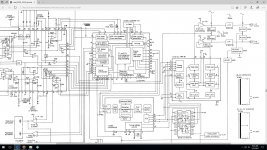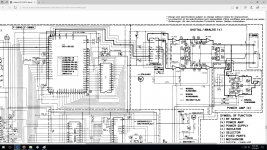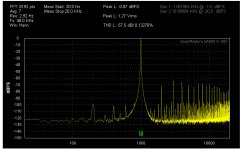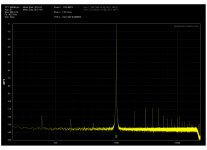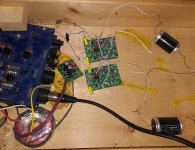I like this post !There are no cookbooks in mixed-signal circuits, no matter how much some people believe in them.
You will find that there are three levels of understanding:
1. people who know enough to make the mod correctly and maintain audio performance
2. people who know they don't know enough to do it correctly, so don't do it
3. people who don't know enough to do it correctly, but do it anyway and don't notice the degradation in audio performance
I am a level 2 person. There are some level 1 people on here, and lots of level 3 people who think they are level 1.
Most (if not all???) non over sampling da converters don't use high quality reconstruction filters (ones that prevent aliasing) or don't use them at all.
Nonetheless high quality analogue reconstruction filters have been made. For the people who want to try them out here's a good read: AES E-Library High Quality Analog Filters for Digital Audio
Are there people here that have made converters using the filters described in this paper? The level 1 people DF96 describes. I would love to hear such a device.
Nonetheless high quality analogue reconstruction filters have been made. For the people who want to try them out here's a good read: AES E-Library High Quality Analog Filters for Digital Audio
Are there people here that have made converters using the filters described in this paper? The level 1 people DF96 describes. I would love to hear such a device.
Last edited:
A reconstruction filter after a DAC removes images, not aliases. Aliases are removed by the anti-alias filter before the ADC.
"to defeat oversampling in a cd player" is a very bad idea that will only worsen the sound quality.
A reconstruction filter after a DAC removes images, not aliases. Aliases are removed by the anti-alias filter before the ADC.
Your right.
20 floggings for me.
That very much depends on the particular CD player (DAC, digital filter) in question.
They have to be exceptionally bad and I don't know any that are THAT bad.
Of cause if you like the added artefacts everything is fine by me, just don't say its better. Say that you like it better with artefacts.
Some old DA chip combinations have the aperture correction on a separate chip. If you remove this chip, high frequencies will be lower in level and can create a "warmer" sound. Lcsaszar has mentioned this method earlier in this thread.
Same effect can of cause easier be achieved with some EQ, with the added bonus of no images and therefore no added IMD.
Players using the SAA7220 benefit from having that removed as its such a current hog (200mA) and noise source. However its no simple matter simply bypassing that as it contains the master clock oscillator.
Yes the SAA7220 does a slight EQ boost (mostly to offset a slight HF loss in the output 3rd order Bessel filter if memory serves) but not sufficient to overcome NOS droop which needs to be implemented separately if the punter is after a flat FR.
Yes the SAA7220 does a slight EQ boost (mostly to offset a slight HF loss in the output 3rd order Bessel filter if memory serves) but not sufficient to overcome NOS droop which needs to be implemented separately if the punter is after a flat FR.
I remember from my EE math class that digital signals could be converted to "perfect" analog below a specified frequency if certain conditions could be met. The conditions were that the pulses were zero width, infinite height and had a finite power. Using finite height pulses of finite width introduced a distortion Sync t/dt (?).
The implication was this distortion could be reduced by increasing the apparent sampling frequency.
Like all things, implementation matters.
There are other factors that also make a difference.
HTH
Doug
The implication was this distortion could be reduced by increasing the apparent sampling frequency.
Like all things, implementation matters.
There are other factors that also make a difference.
HTH
Doug
you should have to start what cd player and what kind of dac is to work on it.
For me ,the tda 1540,1541 is sounds better without the oversampling. it is easy to make one just to take out the 7220 chip. i would do build an I2S attenuator in that chip place, so you get more refind,clean sound....
that is my 2 cents
For me ,the tda 1540,1541 is sounds better without the oversampling. it is easy to make one just to take out the 7220 chip. i would do build an I2S attenuator in that chip place, so you get more refind,clean sound....
that is my 2 cents
Maybe the sin(x)/x response will be sufficient to prevent it, but in principle images could fry your tweeters when you remove the oversampling filter from an existing design without also reducing the analogue filter bandwidth.
Fortunately most of the energy in a music signal is at low frequency, whose images end up near the zeroes of the sinc function.
I just discovered an ancient Sanyo LC7881 DAC in an older cd player and I am enjoying the sound very much; it has the sweet fluidity of TDA1543 combined with great details; I haven't found any service manual of this old player, but I'm wondering if you guys would take a look at these other implementations I attached to see and maybe give some advice if I could force this DAC to NOS mode thus eliminating the digital filter; the first 2 images are from a NAD 5325 , the 3-rd is from a sansui cdx-301i and the 4-th is from a pioneer pd-m500, thanks
Attachments
LC7880
I measured a lot of CD players and I found the Sony CDP-350 with the Sanyo LC7880 had the highest distortion, maybe thats why it sounds so good. 😕
here is two pictures showing 1kHz 0dBfs , the Sony and a Pioneer DVD player.
I measured a lot of CD players and I found the Sony CDP-350 with the Sanyo LC7880 had the highest distortion, maybe thats why it sounds so good. 😕
here is two pictures showing 1kHz 0dBfs , the Sony and a Pioneer DVD player.
Attachments
Very funny indeed how people were chasing for best over/upsampling in the eighties just to claim how good no oversampling sounds today. Yes, even my Sony CDP-101 sounds interesting but is far from today´s solutions like Sabre´s 9018 dacs.
Not oversampling reminds me of the hype on vinyl...
Not oversampling reminds me of the hype on vinyl...
new dac are way better, the critical part is the I/V output stage, and this is where things are still running wild and unclear
new dac are way better, the critical part is the I/V output stage, and this is where things are still running wild and unclear
While the I/V certainly is a critical stage, unfortunately, it is only one among a number of critical stages. I've found no fixed universal formula for satisfying sounding DAC design.
Last edited:
Hi Ken, me neither!
If only it was as simple as a phono cartridge.
I now use this emu 0404 with latest dac
Set up is caddock V out resistors , no filter and no filter capacitor,
the amplification stage works with lots of feedback, feedback capacitors are film powder which sound the best, transistors are matched to reduce output DC and the +-15V is regulated and equalized further to null dac output dc.
Output is going through 1uf tin fim cans which should be bypassed since all my amplifiers designs have input capacitors and 1-2 watts input pots.
If only it was as simple as a phono cartridge.
I now use this emu 0404 with latest dac
Set up is caddock V out resistors , no filter and no filter capacitor,
the amplification stage works with lots of feedback, feedback capacitors are film powder which sound the best, transistors are matched to reduce output DC and the +-15V is regulated and equalized further to null dac output dc.
Output is going through 1uf tin fim cans which should be bypassed since all my amplifiers designs have input capacitors and 1-2 watts input pots.
Attachments
- Status
- Not open for further replies.
- Home
- Source & Line
- Digital Source
- how to defeat oversampling in a cd player.
